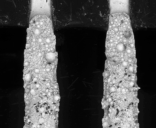Gold Embrittlement of Solder Paste_ Shenzhen Fitech

Gold Embrittlement of Solder Paste_ Shenzhen Fitech
Since gold has excellent conductivity, it is added to some solder pastes and used in plating on PCB and component pins. Gold can play a good role in high humidity and heat environment and is very useful for high cycles (depending on plated layer thickness). It is undoubtable that gold has some problems. Gold is usually the most expensive choice for electroplating products. If the gold-plated layer is too thin, it is easy to cause porous problems. However, If there is a thick gold-plated layer, the solder joints may appear gold embrittlement and cause the mechanical strength to decrease.
When the gold content in the solder joint reaches a certain proportion, the tin gold alloy will exist in the form of AuSn4 and AuSn2. AuSn4 and AuSn2 show brittleness, which is easy to lead to solder joint failure. After a lot of experimental verification, it was found in the industry that when the gold content in the solder is less than 3%, the aging solder joints show ductile fracture after shearing. However, when the gold content in the solder accounts for more than 3% of the total mass, gold embrittlement is more likely to occur. Therefore, the industry generally requires that the gold content in the solder joints shall not exceed 3%. It is generally believed that if the thickness of the gold-plated layer on PCBs or component leads is less than 0.1μm, the gold embrittlement impact can be ignored. Immersion gold and gold-plated devices require the gold layer to protect the internal metal from oxidation. If the gold layer is not thick enough, the protection is insufficient, but if the gold layer is too thick, it will cause gold brittleness.
Case History
Case 1: SMT components peeled off from PCBA. After checking the fracture surface in SEM, it was found that there are a lot of voids in the solder joints, and the cavities contain some residual flux (Figure 1). Careful examination revealed that thin Au-Sn intermetallic platelets(about 0.1-0.2μm) were widely distributed on the fracture surface and the surface of voids.

Figure 1. The SEM image of the failed connector solder joint (severe cavity).
Case 2: EDS was used to measure the gold content in a solder joint, and 10wt% of gold was found. The area fraction of Au-Sn IMC accounted for 28% of the total measured area (Figure 2). The gold content in the tested solder joint was about 3 times the acceptable limit of gold embrittlement.

Figure 2. Microstructure of solder joint. Dark gray area: Sn; Light gray area: Pb; Moderate grey area: Au Sn.
Solution to gold embrittlement
One of the solutions to gold embrittlement is tin plating. Tin plating can wet component leads in advance. The purpose of tin plating is to clean the oxides and foreign matters on the surface of the leads, ensuring the solderability of the leads. The simplest way to prevent gold embrittlement is to remove all gold from the component leads. Tin plating can assist in removing gold. To achieve it, a small tin furnace is used to clean the gold layer from the gold pin, and then the tin plating process is completed in a tin bath. When tin plating, the lead needs to move relative to the molten solder in the tin bath.
Shenzhen Fitech’s lead-free medium-temperature solder pastes do not contain gold, which can well avoid gold embrittlement of solder joints. Medium-temperature solder paste products, such as SAC305, have a melting point of about 217℃, which can be used for reflow soldering, and has excellent solder joint strength.

















 Back to list
Back to list



